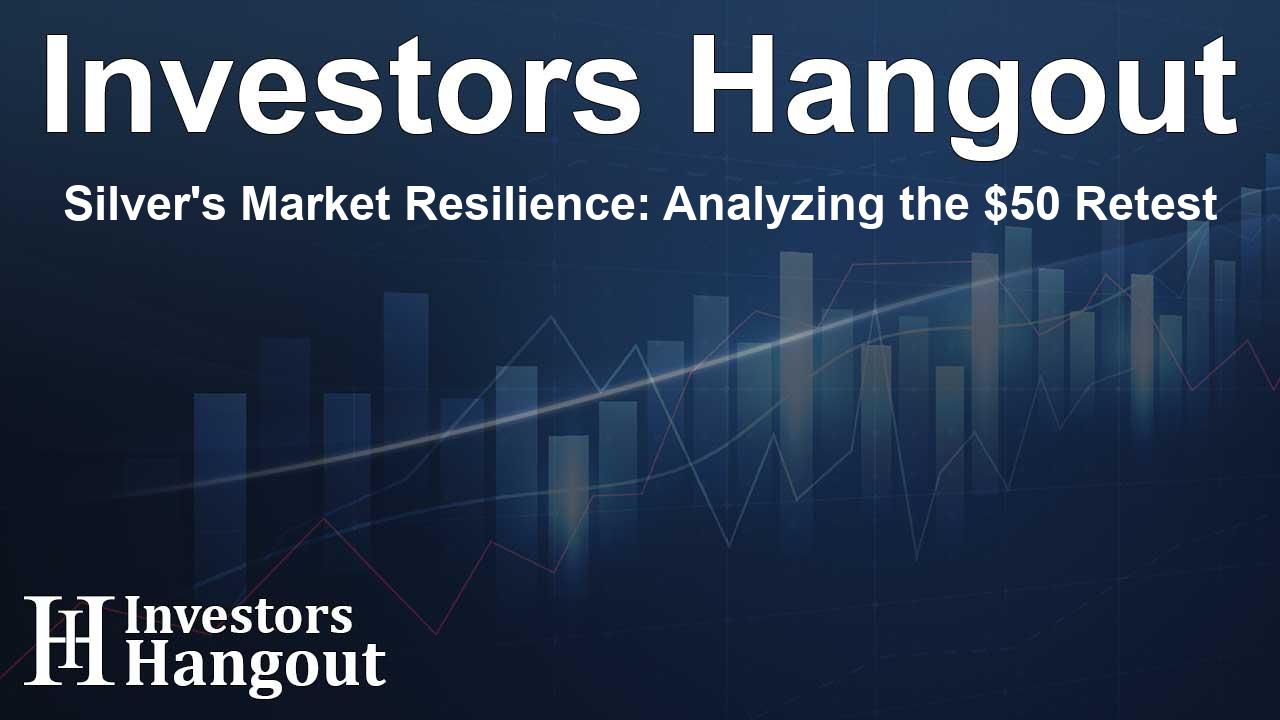Silver's Market Resilience: Analyzing the $50 Retest

Silver’s Journey Through Resistance
Every significant market experience undergoes moments of trial; the instance where values begin to falter right after reaching major milestones. In the case of silver, this pivotal moment has appeared. After surpassing the $50 threshold for the first time in years—a barrier that had confined significant rallies since 1980—the metal is currently engaging in what robust markets typically do: revisiting the foundation of their breakout. This phase signals the beginning of the real contest.
To appreciate why this retest is so critical, and why breaching $50 is no light feat, we must closely analyze the dynamics of the silver market.
Understanding Silver's Key Resistance at $50
Recognizing the significance of the $50 mark in the silver market is essential. For more than four decades, this level has represented both a target and a threshold. Silver first approached this price in 1980, during a prominent market event, and again in 2011 during a commodities boom post-financial crisis. Both occasions observed swift cancellations of rallies, marking psychological scars and technical hurdles that persisted over the years.
This year's move beyond $50 has shed light on the genuine significance of the breakout. The surge past this long-standing barrier in early October emanated from solid fundamentals rather than speculative bubbles or fleeting liquidity. Rising industrial demand, stagnant global mine output, and diminishing above-ground supplies have created a compelling narrative. Moreover, more futures contracts are being settled through physical delivery rather than mere cash settlements. Hence, this breakout wasn't just a fleeting moment, but rather the logical result of ongoing supply-demand shifts.
Nonetheless, no market can shatter decades-old resistance without experiencing bumps along the way. Recognizing $50 as a battlefield underscores its role in testing conviction, implementing production hedges, and encouraging profit-taking among nervous investors. Here, true conviction is contrasted against transient interest.
The fluctuations around the $50 threshold should not be misinterpreted as weakness. They indicate the market's inquiry into whether this former resistance can morph into a stable support. Such retesting serves to alleviate excessive buying momentum, challenge leveraged speculators, and enable long-term investors to reposition. This dynamic solidifies the market's foundation and sets the stage for a more robust ascent.
If this retest ultimately holds, investors might look back years from now and recognize it as the crucial turning point before entering a new pricing paradigm. Like gold’s retest of the $2,000 mark before it skyrocketed, silver's struggles around the $50 mark may mark an end to seeing sub-$50 prices for a considerable duration.
Technical Analysis Indicating Silver's Stability
Examining silver's recent retreat reveals that it more closely resembles a pause than a decline. Following an extended series of advancements, a consolidation was inevitable. Indicators such as the Relative Strength Index (RSI) indicated overbought conditions for over seven weeks. In this context, a brief halt doesn’t indicate a warning; instead, it allows the market to breathe and prepare for its subsequent upward movement.
This cooling down period has prompted some encouraging insights from underlying market structures. One notable signal is the hidden bullish divergence observed on shorter timeframes. This pattern occurs when prices establish higher lows while indicators like MACD form lower lows—signifying strengthening buyer interest beneath the surface, typically preceding further upward motions in sustained trends.
Support from moving averages gives additional clarity; silver has consistently traded above its key short-term moving average (around $44) and significantly above its 26-week SMA (approximately $39), establishing essential mid-term support. These trends have driven the bullish sentiment for months, with no indicators of technical faults, rather a healthy reset in an ongoing upward trajectory.
Silver's Fundamentals Remain Intact
Many investors mistakenly view price declines during corrections as signals of failing narratives. However, this doesn’t apply to silver. The observed weak sentiment reflects more technical elements (cooling momentum and standard profit-taking) than a shift in core fundamentals. The same supply-demand forces influencing silver's breakthrough are still firmly in place and, in many respects, have intensified.
Take, for instance, the physical market, which remains under notable stress. Silver has been trading in backwardation, indicating a preference for immediate physical delivery over delayed contracts, signaling scarcity. Buyers are willing to pay above spot prices for immediate access—a clear indicator of insufficient supply to meet demand.
These patterns play out globally. In regions like Australia, some dealers report premiums exceeding 15% above spot to secure inventory. In China, raw silver experiences astonishing price variations, ranging from $61 to $128 per ounce, underscoring the stark supply disparity. Premiums emerge when metal availability does not meet demand expectations, reinforcing a supply-tight market.
New York's COMEX vault inventories demonstrate a rapid decline. Unlike London’s delayed data releases, COMEX provides daily updates, illustrating sustained demand for physical delivery amidst price corrections. Buyers consistently favor metal ownership over paper contracts.
Supply-side conditions are also contributing to this tight market, with global mine production stagnating and groundbreaking discoveries dwindling. Although recycling provides some relief, it's insufficient to bridge the growing gap in supply. The Silver Institute indicates that there have been five consecutive years of demand outpacing supply, a concerning trend.
Meanwhile, industrial applications continue to expand unabated. The solar and electric vehicle industries—key areas driving silver consumption—show no signs of slowing. The energy transition ensures that demand for silver will rise as new green technologies require vast amounts of the metal.
Gold/Silver Ratio Signals Continued Potential for Silver’s Rise
Another critical indicator suggesting silver's bullish market longevity is the Gold/Silver Ratio (GSR), detailing the number of silver ounces necessary to purchase one ounce of gold. Historically, this ratio has served as a barometer for silver's value relative to gold. Presently, it signals that silver is undervalued compared to its golden counterpart.
Over the last half-century, silver bull cycles frequently conclude once the ratio approaches the 10-30 range. This compression typically coincides with silver outperforming gold just before booms conclude. Historical compressions occurred with silver hitting peaks around 14 in 1980 and 30 in 2011—both instances heralding the final dramatic stages of bull markets.
Currently, the GSR remains above 80, suggesting that silver's position is still within the early phases of its bull cycle. This scenario indicates that there's significant room left for upward movement.
Should history repeat, and the ratio drops into the 10-30 range while gold maintains an above $4,000 price point, the implications for silver’s future are remarkable. Estimates suggest price points could reach anywhere from $133 to $400 per ounce—signaling a drastic need for adjustment relative to gold.
Various Scenarios for Silver’s Future
The road ahead for silver may play out through a range of possible scenarios that largely hinges on how effectively the market navigates the critical $50 retest. Each trajectory reveals varying insights into the current bull market's robustness.
In an ideal scenario, silver sustains the $45-$50 region as staunch support. Momentum indicators like RSI will continue to soften, allowing the market to dissipate overbought conditions, whilst bullish divergence develops. This would likely result in the establishment of a new base for the next upward movement—a perfect instance of a measured consolidation phase.
A more profound, yet plausible scenario might see prices dipping into the low $40s as liquidity is tested and emotions are jostled. While examinations indicate discomfort, historical shakeouts can provide strength by shifting ownership from short-term traders to steadfast investors. So long as the key moving averages remain intact, the predominant bullish trend persists. In effect, such a setback may indeed reveal buying opportunities rather than a trend reversal.
The least plausible outcome would be the complete invalidation of the bull market. For this to occur, a comprehensive shift would need to present itself, including prolonged weekly closings below moving averages signifying a bearish transition. Currently, the signs indicate that what we are witnessing is primarily a structural retest within a much larger bullish narrative.
Concluding Thoughts
The retreat from above $50 should not be confused with weakness; instead, it signifies the market pausing to regain its composure after bursting through a longstanding boundary. Such consolidation is expected and even necessary. It clears the way for momentum recalibration, stabilizes investor sentiment, and permits long-term participants to re-engage while short-term traders withdraw.
The fundamentals behind silver remain strong, with bullish technical setups and shifting market psychology fostering gradual accumulation over panic selling. Each regression entices genuine buyers as opposed to anxious sellers, which is a significant indicator of a maturing bull market.
If the $50 retest holds, it could signify the dawn of a new chapter for silver—a phase where market valuations finally reflect ongoing structural shortages that paper assets can no longer mask. This pullback is not an end but the calm before an anticipated rise.
Frequently Asked Questions
What is the significance of the $50 level for silver?
The $50 mark represents a critical resistance level that has historically impacted silver's price movements, acting as both a target and a psychological barrier.
How does the Gold/Silver Ratio influence market predictions?
The Gold/Silver Ratio provides insight into the relative value of silver compared to gold. A ratio above 80 suggests that silver is still undervalued, indicating room for price growth.
What are the implications of silver trading in backwardation?
Backwardation indicates a strong immediate demand for physical silver, signifying market scarcity and potential upward pressure on prices.
Why is the recent pullback in silver not a cause for concern?
The recent pullback is viewed as a natural pause to allow the market to recalibrate after a strong rally, suggesting the underlying bullish trend remains intact.
What should investors expect in the near future for silver?
Investors may anticipate potential price stabilization as silver manages the $50 retest, ultimately looking for resurgence guided by underlying demand and supply dynamics.
About The Author
Contact Kelly Martin privately here. Or send an email with ATTN: Kelly Martin as the subject to contact@investorshangout.com.
About Investors Hangout
Investors Hangout is a leading online stock forum for financial discussion and learning, offering a wide range of free tools and resources. It draws in traders of all levels, who exchange market knowledge, investigate trading tactics, and keep an eye on industry developments in real time. Featuring financial articles, stock message boards, quotes, charts, company profiles, and live news updates. Through cooperative learning and a wealth of informational resources, it helps users from novices creating their first portfolios to experts honing their techniques. Join Investors Hangout today: https://investorshangout.com/
The content of this article is based on factual, publicly available information and does not represent legal, financial, or investment advice. Investors Hangout does not offer financial advice, and the author is not a licensed financial advisor. Consult a qualified advisor before making any financial or investment decisions based on this article. This article should not be considered advice to purchase, sell, or hold any securities or other investments. If any of the material provided here is inaccurate, please contact us for corrections.
